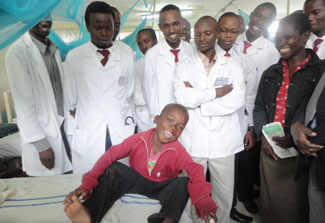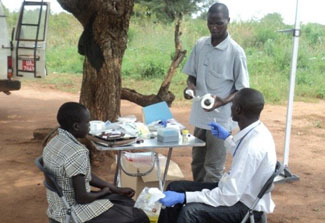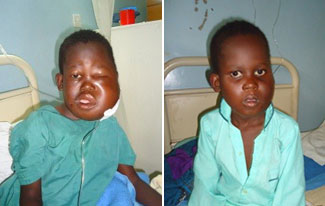Burkitt's lymphoma studies may also advance research on other cancers, HIV, malaria
May / June 2015 | Volume 14, Issue 3

Photos courtesy of Dr. Sam Mbulaiteye
Reinvigorating Burkitt's lymphoma research could save lives, like
this Kenyan boy's, and also generate discoveries that increase
understanding of the interplay among malaria, HIV and the immune
system.
By Cathy Kristiansen
Reinvigorating research on the most common childhood cancer in Africa, Burkitt's lymphoma (BL), could not only save lives of those with the disease but may also produce discoveries with broader implications, according to a recent lecture by a prominent NIH scientist.
Interest in BL is building again, after several decades in which it "hibernated," said Dr. Sam M. Mbulaiteye, a senior investigator at the National Cancer Institute (NCI) and Fogarty collaborator. Scientists have long known that there is a connection between malaria and BL, with more cases of the cancer occurring in high malaria areas. Also, although most BL patients are HIV-negative, having the virus is associated with a 60-fold increased risk of BL in developed countries, although most actual instances in Africa are HIV-negative.
New technologies that reveal the genomic and proteomic involvement in this aggressive cancer provide the potential to advance discoveries, Mbulaiteye suggested. Developing partnerships with existing research platforms devoted to HIV and malaria are critical. "Cooperation could prompt studies to investigate the effect of malaria and HIV interventions on the risk for Burkitt's lymphoma," he said. "In turn, these studies might provide evidence for a causal link between the disease with malaria or with HIV in Africa." At the same time, he added, multidisciplinary and global collaborations for this cancer could build much-needed capacity for pediatric oncology studies in developing countries.

Researchers collecting samples for Burkitt’s lymphoma studies
can also contribute biobank of samples to help advance basic
science, genomics and precision medicine.
As part of his own research, Mbulaiteye recently launched a project in Uganda, Kenya and Tanzania to enroll 1,500 children with Burkitt's lymphoma and 3,000 controls. His team will gather clinical and demographic data, specimens of blood, saliva, stool and tissue, and information on a range of risk factors. The study aims to both expand understanding of the disease and contribute biobank samples, which he hopes will advance research in basic science, genomics and precision medicine.
Burkitt's lymphoma is aggressive - doubling in mass every 24-48 hours - and typically attacks the jaw or abdomen. Early discoveries revealed the cancer's link with the malaria parasite and identified a new microbe - Epstein-Barr virus (EBV) - the first indication viruses could help cause cancer in humans. Additionally, studies showing the success of chemotherapy treatment in BL spurred its use in other malignancies. But research attention dwindled, leaving many questions unanswered, such as why some people are more susceptible, how malaria and EBV might raise the risk in combination or singly, which proteins enhance the development of tumors, and how to identify and protect vulnerable children.
In 2012, the NCI renewed its attention to this cancer. Mbulaiteye has collaborated with researchers in Ghana, Japan, Denmark, Norway, the U.K. and Brazil, as well as within NIH, to conduct epidemiological and clinical research on samples of sick and well children. One surprising finding is that malaria infection is both a risk and a protective factor. Children with BL are less likely to have current or recent blood-stage malaria infection than peers, although scientists previously believed children with the cancer had been weakened by malaria. "This is really making us think in a totally different way about how malaria might be interacting in these kids to induce Burkitt's lymphoma," Mbulaiteye said.

Many African children with Burkitt's lymphoma who reach the
hospital are cured, such as this young patient, shown before
and after receiving treatment.
As with malaria, the role of viruses is still unclear, he noted. EBV is ubiquitous in humans, but patients with tumors have significantly higher associated antibodies than average. One hypothesis is EBV interferes with a regulator gene in ways that spur pathological cell growth. The influence of HIV also needs investigating, given the startlingly high increased BL risk faced by infected people.
Today, chemotherapy cures about 90 percent of patients, but only if they are diagnosed and treated in time - often a challenge in resource-strapped health systems. Mbulaiteye noted that roughly 30-50 percent of African children reaching hospital are cured and many others never even seek professional care. Much more research is needed in the years ahead to reduce these deaths, he said. "I don't think the challenges are those of ideas; they're about sparse data and samples to support new scientific directions."
More Information
Publications and news on Burkitt's lymphoma:
- Elevated serum levels of interleukin-6 in endemic Burkitt lymphoma in Ghana. Aka P et al.
Hematology Oncology, December 2014
- NIH study finds low-intensity therapy for Burkitt lymphoma is highly effective
NCI news release, November 13, 2013
- NIH study shows Burkitt lymphoma is molecularly distinct from other lymphomas
NCI press release, August 13, 2012
- Endemic Burkitt lymphoma is associated with strength and diversity of Plasmodium falciparum malaria stage-specific antigen antibody response. Aka P et al.
Blood, August 1, 2013
- African Burkitt's lymphoma: could collaboration with HIV-1 and malaria programmes reduce the high mortality rate?
The Lancet, May 8, 2010
- Background on discovery of the cancer: Denis Burkitt and the African lymphoma
ecancermedicalscience, September 30, 2009
- NCBI Bookshelf on Burkitt's lymphoma
To view Adobe PDF files,
download current, free accessible plug-ins from Adobe's website.
Related Global Health Research Topics